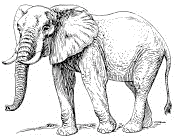
 The best blog post I read today was on TechCrunch, written by Naval Ravikant, an early investor in Twitter, and Adam Rifkin, who I once knew, a long time ago, when he was starting a wonderfully-named company called KnowNow.
The best blog post I read today was on TechCrunch, written by Naval Ravikant, an early investor in Twitter, and Adam Rifkin, who I once knew, a long time ago, when he was starting a wonderfully-named company called KnowNow. 
 I wrote poetry about the name of the company, here on Scripting News.
I wrote poetry about the name of the company, here on Scripting News. 
 Anyway, this post had a single idea that's worth repeating, and remembering whenever you think one of the leading platforms has it wrapped up.
Anyway, this post had a single idea that's worth repeating, and remembering whenever you think one of the leading platforms has it wrapped up. 
 The idea is this: There are many possibe social graphs.
The idea is this: There are many possibe social graphs. 
 The thesis of this piece was that Twitter's graph has different value from Facebook's because its structure of a relationship is more meaningful in some ways.
The thesis of this piece was that Twitter's graph has different value from Facebook's because its structure of a relationship is more meaningful in some ways. 
 In Facebook a friendship is symmetric. If I have a connection to you then you must have a connection to me.
In Facebook a friendship is symmetric. If I have a connection to you then you must have a connection to me. 
 In Twitter, you can have a connection to me, but that does not say that I have a connection to you.
In Twitter, you can have a connection to me, but that does not say that I have a connection to you. 
 Facebook has labels on friendship arcs, I can say you're my lover, wife, or just a friend -- or I can decline to say what our relationship is. But I can't say we have a relationship unless you agree.
Facebook has labels on friendship arcs, I can say you're my lover, wife, or just a friend -- or I can decline to say what our relationship is. But I can't say we have a relationship unless you agree. 
 Facebook relationships represent reality. Twitter relationships represent aspirations.
Facebook relationships represent reality. Twitter relationships represent aspirations. 
 Neither of them has a language for defining relationships, in other words I can't extend the idea of a relationship arbitrarily. And it doesn't seem to be in the DNA of either company to allow others to get in there and mess with this core stuff. (When Twitter started they made it seem like it was their philosophy, but they've been pulling back from that, in some dramatic ways.)
Neither of them has a language for defining relationships, in other words I can't extend the idea of a relationship arbitrarily. And it doesn't seem to be in the DNA of either company to allow others to get in there and mess with this core stuff. (When Twitter started they made it seem like it was their philosophy, but they've been pulling back from that, in some dramatic ways.) 
 No doubt we'll look back at these networks years from now and see them as starting points, because neither now has anything like the full richness of human connection that can be modeled in computers. And of course some relationships will be very difficult to model in a computer's memory. But for now and for the forseeable future, there's lots of growth possible in this form of modeling. Maybe that's why there's so much investment today in tech.
No doubt we'll look back at these networks years from now and see them as starting points, because neither now has anything like the full richness of human connection that can be modeled in computers. And of course some relationships will be very difficult to model in a computer's memory. But for now and for the forseeable future, there's lots of growth possible in this form of modeling. Maybe that's why there's so much investment today in tech. 
 I love blog posts that make me think, or change my thinking.
I love blog posts that make me think, or change my thinking. 
 Good work!!
Good work!! 